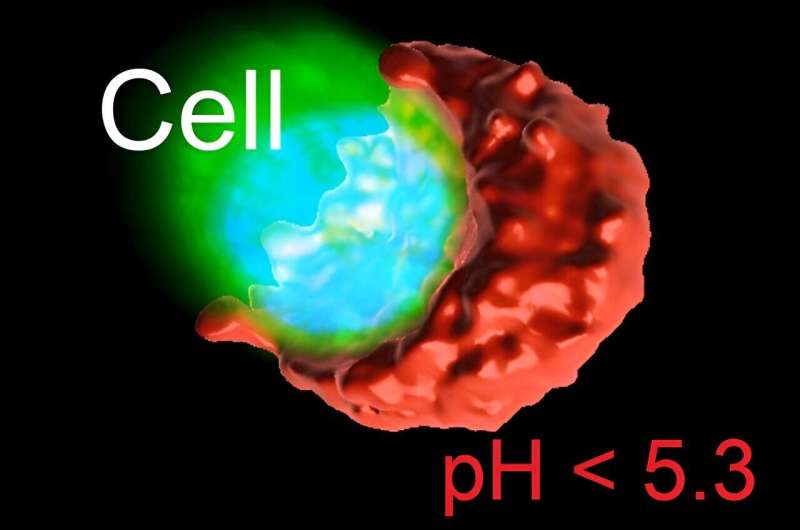This article has been reviewed according to Science X's editorial process and policies. Editors have highlighted the following attributes while ensuring the content's credibility:
fact-checked
peer-reviewed publication
trusted source
proofread
Researchers discover protective 'acid wall' formed by cancer cells

Cancer cells release a significantly more concentrated level of acid than previously known, forming an "acid wall" that could deter immune cells from attacking tumors, UT Southwestern Medical Center scientists show in a new study.
Their findings, published in Nature Biomedical Engineering, could pave the way for new cancer treatment approaches that alter the acidic environment around tumors, the researchers say.
"This study revealed a previously unrecognized polarized extracellular acidity that is prevalent around cancer cells," said study leader Jinming Gao, Ph.D., Professor in the Harold C. Simmons Comprehensive Cancer Center and in the Departments of Biomedical Engineering, Cell Biology, Otolaryngology—Head and Neck Surgery, and Pharmacology at UT Southwestern.
For nearly a century, scientists have known that tumors are acidic (that is, their pH, a measure of acidity, is below 7) but only slightly more than most healthy tissues in the body. For example, the average pH of human muscle at rest is about 7.4, but the average pH of malignant human tumors is about 6.8.
Several years ago, Dr. Gao and his colleagues designed a set of nanoparticles that light up at specific levels of acidity. They found that one called pegsitacianine—which glows at a pH of 5.3—fluoresced brightly in tumors. This nanoparticle has now passed phase two clinical trials in patients as a tool for image-guided cancer surgery.
In 2023, pegsitacianine received Breakthrough Therapy designation by the U.S. Food and Drug Administration, a step that expedites the development and review of promising medicines. However, Dr. Gao said, it was unclear why pegsitacianine fluoresced since a tumor's acidity was thought to be too mild to trigger its activation.
To answer this question, he and his colleagues imaged individual cells sampled from a variety of human and mouse cancer types—including lung, breast, melanoma, and glioblastoma—using pegsitacianine probes. They found that the probes lit up on one side of the cancer cells but not the other, suggesting that their acidity was polarized. This acidity results from the secretion of lactic acid, which tumor cells produce as a waste product after digesting glucose, or blood sugar.
When they did similar experiments in tumor tissue, imaging showed that the cancer cells preferentially pumped acid away from neighboring cancer cells and into the extracellular environment, forming a zone of higher acidity at the tumors' edge.
Samples from human tumors showed that this acid wall was practically devoid of CD8+ T cells within the tumors, an immune cell type known to fight cancer. When the researchers grew cancer cells and CD8+ T cells together in petri dishes that had been acidified to a 5.3 pH, the cancer cells were spared while the CD8+ T cells perished within three hours, suggesting that this severe acidity might thwart immune cell attack without harming the cancer cells.
Previous research from the Gao Lab has also shown that lactate, the basic counterpart of lactic acid, enhances the anti-cancer activity of immune cells. Since lactic acid appears to do the opposite, future treatment strategies may focus on converting lactic acid to lactate to promote an immune attack, Dr. Gao said.
Other potential treatments currently under investigation at UTSW and elsewhere that harness tumors' relative acidity, such as pH-sensitive drug carriers that release chemotherapy inside tumors, could need adjustments based on the higher acidity revealed in this study, he added.
Dr. Gao noted that this discovery will lead to several new lines of research, such as studies to better understand how cancer cells polarize their acid excretion, how those cells can withstand the acidity level that kills CD8+ T cells, and how to inhibit acid excretion to allow T cells to better kill cancer cells.
More information: Qiang Feng et al, Severely polarized extracellular acidity around tumour cells, Nature Biomedical Engineering (2024). DOI: 10.1038/s41551-024-01178-7
















